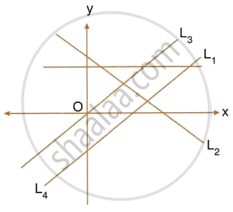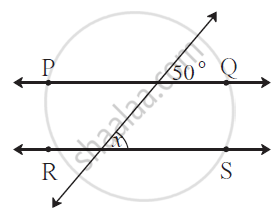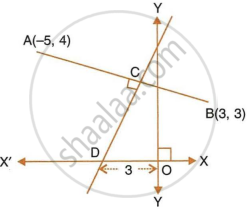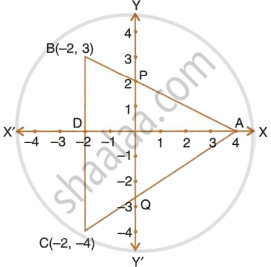Advertisements
Advertisements
प्रश्न
Find the equation of the line passing through (−2, 1) and perpendicular to 4x + 5y = 6.
उत्तर
4x + 5y = 6
5y = −4x + 6
`y = (-4x)/5 + 6/5`
Slope of this line = `(-4)/5`
The required line is perpendicular to the line 4x + 5y = 6.
∴ Slope of the required line = `(-1 )/"slope of the given line"`
= `(-1)/((-4)/5)`
= `5/4`
The required equation of the line is given by
y − y1 = m(x − x1)
`y − 1 = 5/4 (x + 2)`
4y − 4 = 5x + 10
5x − 4y + 10 + 4 = 0
5x − 4y + 14 = 0
APPEARS IN
संबंधित प्रश्न
Write the equation of the line passing through the pair of points (2, 3) and (4, 7) in the form of y = mx + c.
Given 3x + 2y + 4 = 0
(i) express the equation in the form y = mx + c
(ii) Find the slope and y-intercept of the line 3x + 2y + 4 = 0
Is the line 3x + 4y + 7 = 0 perpendicular to the line 28x – 21y + 50 = 0?
B(−5, 6) and D(1, 4) are the vertices of rhombus ABCD. Find the equations of diagonals BD and AC.
The point P is the foot of perpendicular from A(−5, 7) to the line whose equation is 2x – 3y + 18 = 0. Determine :
- the equation of the line AP.
- the co-ordinates of P.
Match the equations A, B, C and D with the lines L1, L2, L3 and L4, whose graphs are roughly drawn in the given diagram.
A ≡ y = 2x;
B ≡ y – 2x + 2 = 0;
C ≡ 3x + 2y = 6;
D ≡ y = 2

In the figure, line PQ || line RS. Using the information given
in the figure find the value of x.

Find:

- equation of AB
- equation of CD
Three vertices of a parallelogram ABCD taken in order are A(3, 6), B(5, 10) and C(3, 2), find:
- the co-ordinates of the fourth vertex D.
- length of diagonal BD.
- equation of side AB of the parallelogram ABCD.
In the figure, given, ABC is a triangle and BC is parallel to the y-axis. AB and AC intersect the y-axis at P and Q respectively.

- Write the co-ordinates of A.
- Find the length of AB and AC.
- Find the radio in which Q divides AC.
- Find the equation of the line AC.
